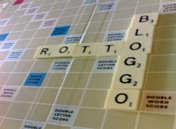
This was written a few weeks ago but is unlikely to get a run in the POST: it mentions the beautiful island, so it gets a run on Rotto Bloggo...
Exploitation of Aborigines…shocking treatment of the first Australians…no help for the indigenous.
Not recent headlines from our daily paper: this news was reported in The West and the Inquirer 124 years ago.
Anglican reverend John Gribble kept a diary of his pastoral tour Gascoyne sheep stations. Its publication caused a major fuss: Gribble was assaulted on a ship to Fremantle, and Perth worthies like Winthrop Hackett and Charles Harper stayed their donations to the new cathedral.
Later Gribble sued The West after the paper called him a liar. He lost the case when he admitted much of his diary was hearsay, and died, miserable, seven years later.
That was the Gribble affair, and it’s one of hundreds of entries in the Historical Encyclopedia of Western Australia.
General readers and even keen students of our great state’s past will learn much from this new reference work.
Older POST readers will remember eating out at the Seacrest in Cottesloe. That establishment is mentioned in the lengthy and excellent entry on eating places – but many will be surprised to learn Perth had more than one Chinese restaurant as early as World War Two.
Other entries are just as informative and intriguing. Whaling in WA is well-known, but details on the state’s sealing are given. Other entries on bridges, class, state hotels, race riots, landcare, diet, Section 54B, the Pilbara strike, capital punishment and white-collar convicts are educational and entertaining.
The entries on birth and death show the Encyclopedia at its best. In the former, Carol Thorogood gives a well-written sense of how West Australians have entered the world. At the other end of the mortal coil Leonie Liveris touches on how we died and how others reacted: ‘After 1945 women were at liberty to attend funerals, there was no set period for formal mourning, no black-edged stationery and black crepe armbands were rarely worn by men’.
There are no biographical entries: the editors say this is because they’re already covered by the Australian Dictionary of Biography. Reading a WA encyclopedia without seeing entries on C.Y. O’Connor and Edith Cowan, however, is like looking at a street directory without the highways.
At times persistence pays when reading the Encyclopedia. For example: we were keen to see an entry on the Claremont serial killings, so we turned to crime. No entry there, and none for serial killers – but we eventually found a mention in the very capable entry on murders.
There’s no entry on Claremont Teachers’ College, but it gets a mention in teacher training.
No reference work can include everything or please everyone. There’s an excellent entry on theatre buildings, for example, but none on Subiaco Oval or the WACA.
There are no entries on the western suburbs as a place, the six hungry families, ophthalmology, Tranby House, vexillology or bread/baking.
There’s an entry on Royal Perth Hospital, but it’s odd that institution’s write-up is the same length as the Royal WA Historical Society.
The entry on pacifism is curious. It “has rarely been a significant force” in WA, but then details peace groups, demonstrations and the “increasingly large” anti-Vietnam crowds.
The entry on rock music doesn’t mention the Snake Pit – but that notorious beachside hangout gets a nod in popular music, nightlife and youth culture.
In entrepreneurs we read about Claude de Bernales but not Alan Bond. The latter does get a mention in real estate and land development.
From a journalist’s point of view, the many media entries are detailed and well-written.
This book was a long time coming: the idea was hatched in the early 1990s. At the launch an online edition was hoped for. An Internet version would almost certainly be used by more people than the $89.95 edition.
Online isn’t the answer to everything. The Encyclopedia’s entry on The Sunday Times, for example, is superior to Wikipedia’s version.
But compare the Encyclopedia’s and Wikipedia’s Rottnest island efforts. The print version is very capable, but it can’t compete with the pictures and text at Wikipedia.
So far this year the Wikipedia article on Rottnest has been viewed nearly 22,000 times. How many people will read the Encyclopedia’s version?
Historical Encyclopedia of Western Australia
Edited by Jenny Gregory and Jan Gothard
UWA Press, $89.95


Using any encyclopedia is more difficult without a comprehensive index. I think I heard an online one was in preparation, but I'm unsure.
ReplyDeleteOne noteworthy omission I noticed in the list of songs about Western Australia (pp. 984-989) was Kevin 'Bloody' Wilson's "Kalgoorlie Love Songs." Too rude for history perhaps? :)
The importance of "The snake pit" is possibly overrated. I saw it operating when it was popular in the 1950s, but there were arguably more popular Rock 'n Roll venues at the Point Walter and Bicton Baths Tearooms, both which have long been demolished. One of the really significant Jive and Rock 'n Roll venues was on Saturday afternoons at the old Embassy Ballroom in central Perth, where the Parmelia Hotel now stands. I also saw Louis Armstrong (Satchmo) perform a concert there in the early 60s.
I haven't noticed a review of the Encyclopedia in 'The West Australian.' Maybe I missed it?
Cheers, Paul.